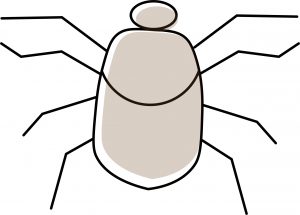 The term “house dust mites” (HDM) has been applied to a large number of microscopic mites found in dust in dwellings. However Dermatophagoides farinae and Dermatophagoides pteronyssinus, and a third species Euroglyphus maynei which also occurs widely, are the most important allergens for persistent asthma and rhinitis worldwide. Mite’s exoskeleton and gut contains the major allergens, which are also highly cross-reactive. HDM feed on shed skin of man and flourish in the stable environment of dwellings.
The term “house dust mites” (HDM) has been applied to a large number of microscopic mites found in dust in dwellings. However Dermatophagoides farinae and Dermatophagoides pteronyssinus, and a third species Euroglyphus maynei which also occurs widely, are the most important allergens for persistent asthma and rhinitis worldwide. Mite’s exoskeleton and gut contains the major allergens, which are also highly cross-reactive. HDM feed on shed skin of man and flourish in the stable environment of dwellings.
Dust mites survive in mattresses, where they tend to spend a third of their lives, and other warm, dusty environments. They are sensitive to relative humidity and at 60% or lower the mite population stops growing and dies out.
Perennial rhinitis is most often due to allergy to the house dust mite and asthma is associated to rhinitis in a considerable amount of cases. Since mites live and thrive in many sites throughout the house, they are difficult to reduce and impossible to eradicate. The results of studies suggest that use of acaricides (products to kill house dust mites) and extensive bedroom-based environmental control programs may be of some benefit in reducing rhinitis symptoms. However, no single measure has been shown to be effective in reducing asthma symptoms. The association between HDM and atopic dermatitis has long been a contested issue even if there is evidence for exogenous elicitation of atopic dermatitis by contact with aeroallergens as HDM.
Storage mites occur frequently in grain stores, animal feed, flour mills, and cheese stores, also infesting confectionary industry and bakeries. Main storage mites are Acarus siro, generally living inside grain, Lepidoglyphus destructor, cosmopolitan food mite generally found on the grain surface and around debris, and Tyrophagus putrescentiae, mould mite requires damper, warmer conditions often in association with fungi. Storage mites are often involved in occupational asthma and rhinitis.
Cockroach infestation has also been shown to be an important cause of allergic sensitization, particularly in inner-city homes in the US. In Europe, the clinical importance of cockroach allergy is still debated. The most common domiciliary cockroach species are the American (Periplaneta americana), and the German (Blattella germanica). Cockroach allergens are derived from several sources, such as saliva, fecal material, secretions, cast skins, debris, and dead bodies. Cockroach allergens have been detected not only in homes but also in public buildings like schools. Also in the case of cockroach, avoidance measures are only partially effective.
